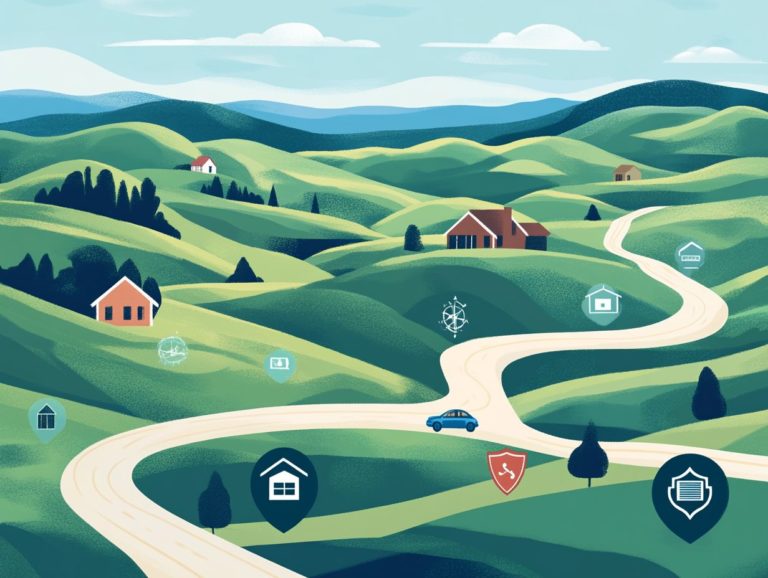Understanding Auto Insurance Laws in California
Navigating the world of auto insurance can feel overwhelming, especially in a state as diverse as California.
Understanding the laws surrounding auto insurance is essential for every driver. This includes grasping minimum coverage requirements and mastering the intricacies of filing a claim.
This guide clearly explains the key aspects of auto insurance in California, covering:
- Liability coverage
- Additional options like collision and comprehensive coverage
- The penalties for driving without insurance
You ll also uncover practical tips for finding the best policy tailored to your unique needs. Whether you re a new driver or simply refreshing your knowledge, this information will empower you to make informed decisions.
Contents
- Key Takeaways:
- Overview of Auto Insurance Laws in California
- Minimum Coverage Requirements in California
- Additional Coverage Options
- Penalties for Driving Without Insurance in California
- How to File a Claim in California
- Tips for Finding the Best Auto Insurance in California
- Frequently Asked Questions
- What happens if I am caught driving without insurance in California?
- Can I get temporary insurance in California?
- Do I need to tell my insurance company if I move in California?
Key Takeaways:

- In California, carrying auto insurance isn’t just a requirement it’s your safety net on the road! Drivers must have minimum liability and uninsured/underinsured motorist coverage to legally operate a vehicle.
- Additional coverage options such as collision and comprehensive can provide added protection, but are not required by law.
- Driving without insurance in California may lead to hefty fines, license suspension, and difficulties in filing a claim after an accident.
Overview of Auto Insurance Laws in California
Understanding auto insurance laws in California is essential for drivers like you. These laws detail the coverage options available and the minimum liability insurance requirements.
They also outline the legal responsibilities designed to protect your financial interests while navigating the road. Governed by the California Insurance Code, these regulations demand that you meet specific proof of insurance requirements, which are documents showing you have auto insurance, to keep your driver s license and vehicle registration in good standing.
These laws play a critical role in reducing risks related to accidents. They ensure that compensation is available for affected parties and impose legal penalties for infractions such as driving without insurance.
What is Auto Insurance?
Auto insurance is your financial safety net, crafted to cover the costs linked to vehicle accidents, theft, and damages. It ensures you meet your financial obligations in California.
This essential policy not only shields you from unforeseen expenses but also serves as a vital requirement for operating a vehicle legally. In California, auto insurance provides a range of coverage options.
- Liability coverage handles the costs associated with injuries or damages you might cause to others in an accident.
- Personal injury protection ensures that medical expenses for you and your passengers are covered, regardless of who is at fault.
- Comprehensive coverage protects you against non-collision incidents like theft or natural disasters.
With this peace of mind, you can hit the road knowing you re prepared for whatever surprises may come your way.
Minimum Coverage Requirements in California
California’s minimum coverage requirements for auto insurance provide you with essential financial protection. This ensures you adhere to state laws and safeguards you while alleviating the risks linked to vehicle accidents.
By meeting these requirements, you position yourself to navigate the roads with greater peace of mind.
Liability Coverage
Liability coverage is an essential part of auto insurance, crafted to shield you from financial loss if you re held responsible for causing bodily injury or property damage to others.
This type of insurance typically consists of two key components: bodily injury liability and property damage liability coverage. Bodily injury liability insurance takes care of medical expenses, lost wages, and even pain and suffering for those injured in an accident you caused.
On the flip side, property damage liability covers the costs of repairing or replacing vehicles or property that sustained damage during the incident. Grasping these elements is vital, especially in California, where the law mandates minimum coverage levels.
By meeting these requirements, you not only protect yourself financially but also play a role in fostering a safer community by being accountable for your actions on the road.
Uninsured/Underinsured Motorist Coverage

Uninsured and underinsured motorist coverage is crucial for safeguarding yourself against the financial fallout from accidents involving negligent drivers. These drivers often don t have enough insurance.
This type of coverage ensures that your expenses whether it s medical bills, vehicle repairs, or lost wages are managed even when the responsible party is underinsured or completely uninsured. In California, where the roads are a whirlwind of activity, encounters with uninsured motorists are all too frequent. Having this coverage becomes particularly essential.
Imagine being struck by a driver who has no insurance or whose policy falls short of covering the damages. In that scenario, having this protection can be the key to maintaining your financial stability instead of spiraling into overwhelming debt.
Without it, you could find yourself dealing with high out-of-pocket costs, navigating a complicated legal maze all on your own while trying to recover from the accident’s aftermath.
Additional Coverage Options
You have the opportunity to enhance your auto insurance policy with additional coverage options. These options offer you greater protection and peace of mind in various circumstances that extend beyond basic liability coverage.
Investing in these options can provide you with the confidence you need while navigating the roads.
Collision Coverage
Collision coverage empowers you to handle the costs associated with damages to your vehicle resulting from a collision, whether it’s with another vehicle or an object. It does so regardless of who s at fault.
This type of coverage is essential because it lifts the financial weight of repairs or replacement, allowing you to return to the road without delay. By choosing collision coverage, you protect yourself from unforeseen repair expenses and simplify the process of filing an accident claim.
When included in a full coverage insurance, it enhances your overall protection by addressing a range of risks, such as theft or natural disasters. Understanding the benefits of collision coverage is essential for fulfilling your comprehensive insurance needs.
Comprehensive Coverage
Comprehensive coverage is an optional auto insurance policy designed to shield you from damages not related to collisions, such as theft, vandalism, and the unpredictable forces of nature.
This type of coverage can be particularly vital if you reside in areas susceptible to severe weather events like hurricanes, floods, or hailstorms. It provides peace of mind against costly repairs that can arise from these unforeseen occurrences.
It also protects you from the increasing risk of vandalism, especially in urban settings, ensuring that damage caused by malicious acts won t hit your wallet. In regions where wildlife is abundant, comprehensive coverage can safeguard you against incidents involving animal strikes, allowing you to drive with greater confidence and security on the road.
Penalties for Driving Without Insurance in California
Driving without insurance in California can lead to serious legal repercussions, including hefty fines, suspension of your license, and heightened insurance premiums.
This situation highlights the critical importance of complying with state insurance requirements to protect both your financial well-being and your driving privileges. Don t risk hefty fines or losing your driving privileges make sure you re covered!
Fines and Possible License Suspension

Avoid fines make sure you have insurance to protect your finances! Fines for driving without insurance can be quite substantial, particularly in California, where the law permits license suspensions as a serious consequence for not adhering to financial responsibility rules.
These penalties impose immediate financial burdens on you, with base fines often exceeding $100. However, the costs don t stop there. You may also face additional expenses like reinstatement fees and higher insurance premiums in the future. When you fail to provide proof of insurance, your license could be suspended, further complicating matters and making it challenging to secure affordable auto insurance later on.
This creates a frustrating cycle. Finding more manageable insurance rates becomes increasingly difficult. Many providers view a history of penalties as a red flag, which can lead to higher premiums or even outright denials of coverage.
How to File a Claim in California
Filing a claim in California after an auto accident requires you to navigate several essential steps. This process is designed to ensure you receive the compensation and support you need from your insurance company.
Steps to Take After an Accident
After an accident, it s essential to follow specific steps to protect your rights and smooth out the claims process. Start by documenting the scene and reaching out to your insurance company.
First and foremost, ensure everyone s safety. Check on all parties involved and, if necessary, move to a secure area. Next, promptly gather crucial details: witness statements, photographs of the scene, and any visible damage to vehicles. Don t forget to notify the police; their official report can be invaluable for your insurance claims.
Once you ve addressed immediate concerns, your next priority should be initiating the claim process with your insurance company. This means reporting the incident and providing all collected evidence to bolster your case.
Tips for Finding the Best Auto Insurance in California
Finding the best auto insurance in California demands careful attention to several key factors. You’ll need to evaluate coverage options, compare insurance rates, and consider your unique driving needs.
Each driver has distinct requirements, so taking the time to assess these elements will help you make an informed decision tailored to your situation.
Factors to Consider
When you re on the hunt for auto insurance, several critical factors deserve your attention. These include the insurer s reputation, coverage options, and overall premiums. These elements are pivotal in shaping your decision-making process.
An insurer s reputation often mirrors customer satisfaction and claims support, offering you valuable insights into the experiences of others. Exploring coverage options empowers you to tailor your policy to meet your specific needs, whether you re considering liability or comprehensive coverage (coverage that protects against various risks, including theft and damage).
Analyzing insurance premiums is essential for grasping the financial commitment at hand. This ensures that your chosen plan harmonizes with both your current budget and long-term financial goals.
Frequently Asked Questions

What are the minimum auto insurance requirements in California?
All drivers in California are required to have liability insurance with the following minimum coverage: $15,000 for injury or death of one person, $30,000 for injury or death of multiple people, and $5,000 for property damage.
Do I need to have uninsured/underinsured motorist coverage in California?
Yes, it is required for all drivers to have uninsured/underinsured motorist coverage with the same minimum limits as liability insurance.
Can I use my out-of-state auto insurance in California?
No, if you are a California resident, you must have auto insurance that meets the state’s requirements. Out-of-state insurance policies are not acceptable in California.
What happens if I am caught driving without insurance in California?
If you drive without insurance in California, expect a fine up to $500. Your vehicle may also be impounded, and your driver’s license could be suspended.
Can I get temporary insurance in California?
Yes! Some insurance companies provide temporary auto insurance for up to 30 days. This is perfect for anyone borrowing or renting a vehicle for a short stint.
Do I need to tell my insurance company if I move in California?
Absolutely! Notify your insurance company about any address change. This ensures your policy stays valid and your coverage is right for your new location.



